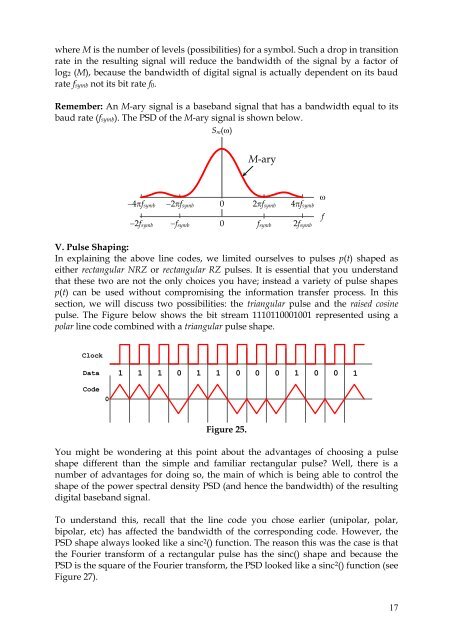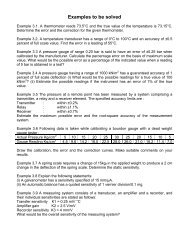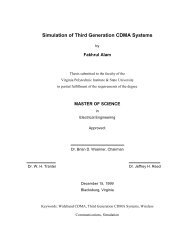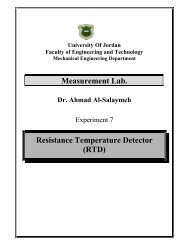Communications I Dr. Mohammed Hawa Introduction to Digital - FET
Communications I Dr. Mohammed Hawa Introduction to Digital - FET
Communications I Dr. Mohammed Hawa Introduction to Digital - FET
You also want an ePaper? Increase the reach of your titles
YUMPU automatically turns print PDFs into web optimized ePapers that Google loves.
where M is the number of levels (possibilities) for a symbol. Such a drop in transitionrate in the resulting signal will reduce the bandwidth of the signal by a fac<strong>to</strong>r oflog2 (M), because the bandwidth of digital signal is actually dependent on its baudrate fsymb not its bit rate f0.Remember: An M-ary signal is a baseband signal that has a bandwidth equal <strong>to</strong> itsbaud rate (fsymb). The PSD of the M-ary signal is shown below.S m (w)M-ary-4pf symb -2pf symb02pf symb 4pf symbf-2f symb 0-f symbf symb2f symbwV. Pulse Shaping:In explaining the above line codes, we limited ourselves <strong>to</strong> pulses p(t) shaped aseither rectangular NRZ or rectangular RZ pulses. It is essential that you understandthat these two are not the only choices you have; instead a variety of pulse shapesp(t) can be used without compromising the information transfer process. In thissection, we will discuss two possibilities: the triangular pulse and the raised cosinepulse. The Figure below shows the bit stream 1110110001001 represented using apolar line code combined with a triangular pulse shape.ClockData 1 1 1 0 1 1 0 0 0 1 0 0 1Code0Figure 25.You might be wondering at this point about the advantages of choosing a pulseshape different than the simple and familiar rectangular pulse? Well, there is anumber of advantages for doing so, the main of which is being able <strong>to</strong> control theshape of the power spectral density PSD (and hence the bandwidth) of the resultingdigital baseband signal.To understand this, recall that the line code you chose earlier (unipolar, polar,bipolar, etc) has affected the bandwidth of the corresponding code. However, thePSD shape always looked like a sinc 2 () function. The reason this was the case is thatthe Fourier transform of a rectangular pulse has the sinc() shape and because thePSD is the square of the Fourier transform, the PSD looked like a sinc 2 () function (seeFigure 27).17
















